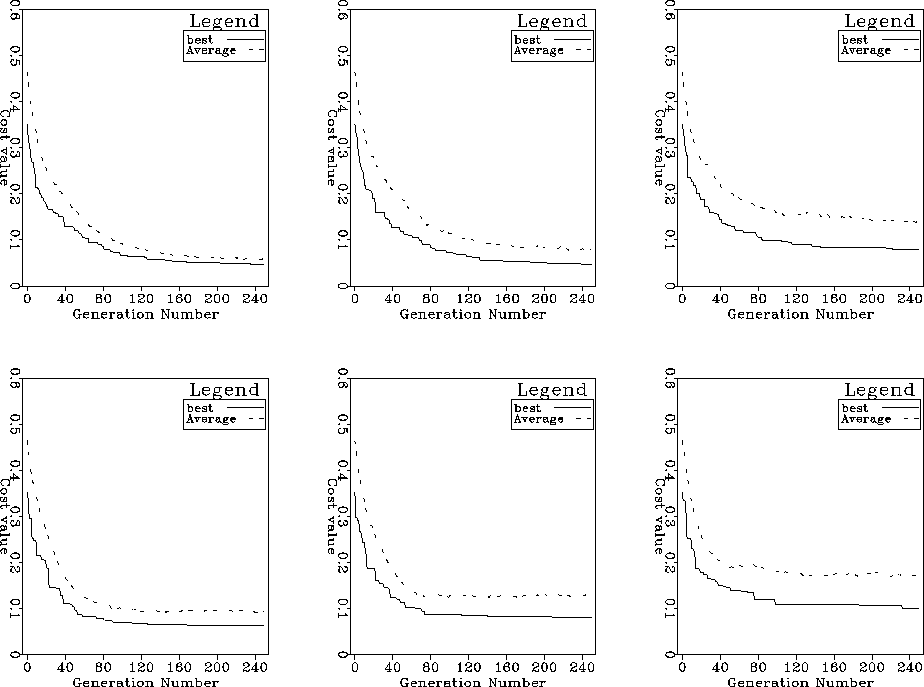




Next: Other options
Up: Parameter Selection
Previous: Crossover Rate
As mentioned in Appendix A, there are two types of mutation operators: the
standard jump mutation that acts on the chromosome (binary representation of
the individual, sometimes called genotype) and creep mutations that act
on the decoded individual, sometimes called phenotype. In any case, the
mutation probabilities are expected to be low, since high values may cause
strong disruption of promising schemata and therefore steer the algorithm
away from the most promising regions of the search landscape.
The top panels of Figure ![[*]](http://sepwww.stanford.edu/latex2html/cross_ref_motif.gif) show a comparison of
convergence rates for three values of jump mutation probability 0.002, 0.004
and 0.008, without creep mutations. In this case a jump mutation of 0.002
is the best although a value of 0.005 would have been expected from the
rule of thumb of the inverse of the population size. The bottom panels of
Figure
show a comparison of
convergence rates for three values of jump mutation probability 0.002, 0.004
and 0.008, without creep mutations. In this case a jump mutation of 0.002
is the best although a value of 0.005 would have been expected from the
rule of thumb of the inverse of the population size. The bottom panels of
Figure ![[*]](http://sepwww.stanford.edu/latex2html/cross_ref_motif.gif) show the effect of creep mutations with
probabilities of 0.02, 0.04 and 0.08. Again, it seems that a small mutation
is actually best. For the remaining I used creep mutation with probability 0.02.
SG_compare_mutation1
show the effect of creep mutations with
probabilities of 0.02, 0.04 and 0.08. Again, it seems that a small mutation
is actually best. For the remaining I used creep mutation with probability 0.02.
SG_compare_mutation1
Figure 7 Comparison of convergence
rates for different jump and creep mutation rates. Top panels for jump
mutation rates of 0.002, 0.004 and 0.008. Bottom panels for creep mutation
rates of 0.02, 0.04 and 0.08.










Next: Other options
Up: Parameter Selection
Previous: Crossover Rate
Stanford Exploration Project
11/11/2002

![[*]](http://sepwww.stanford.edu/latex2html/cross_ref_motif.gif) show a comparison of
convergence rates for three values of jump mutation probability 0.002, 0.004
and 0.008, without creep mutations. In this case a jump mutation of 0.002
is the best although a value of 0.005 would have been expected from the
rule of thumb of the inverse of the population size. The bottom panels of
Figure
show a comparison of
convergence rates for three values of jump mutation probability 0.002, 0.004
and 0.008, without creep mutations. In this case a jump mutation of 0.002
is the best although a value of 0.005 would have been expected from the
rule of thumb of the inverse of the population size. The bottom panels of
Figure ![[*]](http://sepwww.stanford.edu/latex2html/cross_ref_motif.gif) show the effect of creep mutations with
probabilities of 0.02, 0.04 and 0.08. Again, it seems that a small mutation
is actually best. For the remaining I used creep mutation with probability 0.02.
show the effect of creep mutations with
probabilities of 0.02, 0.04 and 0.08. Again, it seems that a small mutation
is actually best. For the remaining I used creep mutation with probability 0.02.
